7006EHR Critical Essay: Digital World's Impact on HRM & Work
VerifiedAdded on 2022/07/27
|9
|2419
|23
Essay
AI Summary
This essay critically analyzes the implications of the digital world on the future of work, the workforce, and human resource management. It explores the transformative impact of digital technologies such as AI, mobile platforms, and social collaboration systems on how people work and live. The essay discusses the emergence of digital workplaces, emphasizing the shift from traditional siloed environments to more dynamic and connected ones. It examines how big data and algorithms are automating cognitive tasks and the rise of digital fluency among the workforce. Furthermore, the essay delves into the importance of employee connectedness, responsive leadership, and the role of IT leaders in fostering a successful digital workplace. It also highlights the need for HRM functions to embrace technology and adapt to the changing landscape, providing key lessons for successful digital transformation. The essay concludes by emphasizing the significant impact of the digital world on reshaping traditional processes and enhancing productivity in the workplace.
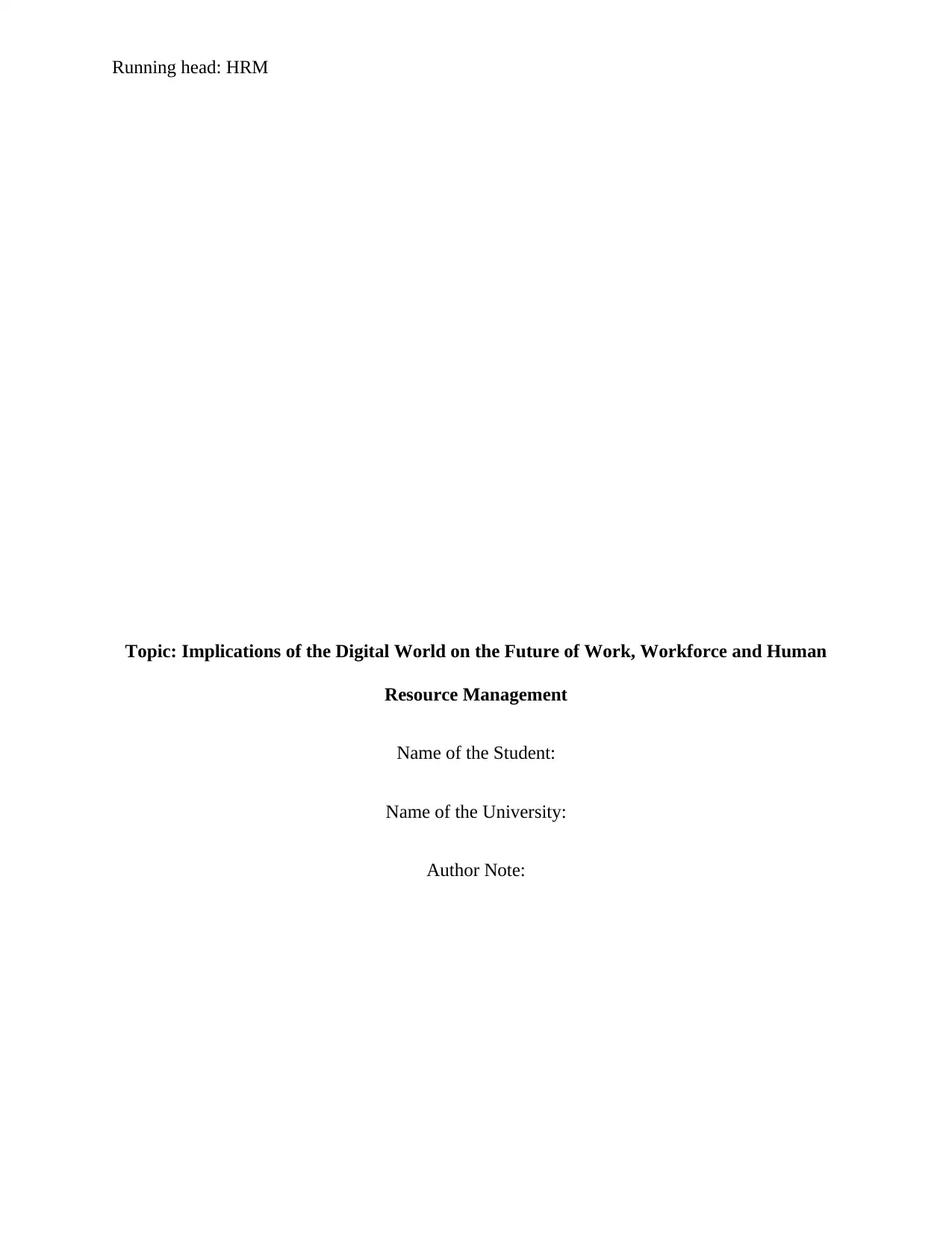
Running head: HRM
Topic: Implications of the Digital World on the Future of Work, Workforce and Human
Resource Management
Name of the Student:
Name of the University:
Author Note:
Topic: Implications of the Digital World on the Future of Work, Workforce and Human
Resource Management
Name of the Student:
Name of the University:
Author Note:
Paraphrase This Document
Need a fresh take? Get an instant paraphrase of this document with our AI Paraphraser

HRM 1
Introduction:
The essay provides an insight into the implications of the digital world on future of work,
work force and the human resource management. People are now living within a Digital Era
where the enhancement of technologies is bringing about transformation in the ways in which
people work and live. According to the Human Capital Trends report put forward by Deloitte
(2017), it has been found that latest technologies like Artificial Intelligence (AI), mobile
platforms, sensors, social system of collaboration has dramatically brought about a
transformation in the ways people work, live as well as communicated but at accelerated pace.
Today’s workforce comprises of both the digital natives as well as the immigrants.
Technological developments has compelled the organizations in adopting digital work with
evolved features (Cianni & Steckler, 2017). To reflect the dramatic change in the work
experience of employees, the organizations are increasingly embracing and adopting a digital
workplace. Technology is influencing the business persistently. This study will explore the
consequences of this digital world by measuring whether it is successful in spelling positive
implications on the future of the work, workforce and human resource management.
Discussion:
According to Stieglitz & Brockmann (2012), the work environments in the traditional
organizations has been characterized by siloed technologies, isolated physical spaces and the
non-synchronous email communications. This implied that technologies, behavior as well as
physical constraints in such workplaces resulted in fundamental disconnection between the
employee accomplishment and the needs of the firms which was unlike the digital era. However,
with the emergence of the digital world companies has been increasing responsive towards
challenges posed by the era through redesigning its workforce (Köffer, 2015). The outcomes of
Introduction:
The essay provides an insight into the implications of the digital world on future of work,
work force and the human resource management. People are now living within a Digital Era
where the enhancement of technologies is bringing about transformation in the ways in which
people work and live. According to the Human Capital Trends report put forward by Deloitte
(2017), it has been found that latest technologies like Artificial Intelligence (AI), mobile
platforms, sensors, social system of collaboration has dramatically brought about a
transformation in the ways people work, live as well as communicated but at accelerated pace.
Today’s workforce comprises of both the digital natives as well as the immigrants.
Technological developments has compelled the organizations in adopting digital work with
evolved features (Cianni & Steckler, 2017). To reflect the dramatic change in the work
experience of employees, the organizations are increasingly embracing and adopting a digital
workplace. Technology is influencing the business persistently. This study will explore the
consequences of this digital world by measuring whether it is successful in spelling positive
implications on the future of the work, workforce and human resource management.
Discussion:
According to Stieglitz & Brockmann (2012), the work environments in the traditional
organizations has been characterized by siloed technologies, isolated physical spaces and the
non-synchronous email communications. This implied that technologies, behavior as well as
physical constraints in such workplaces resulted in fundamental disconnection between the
employee accomplishment and the needs of the firms which was unlike the digital era. However,
with the emergence of the digital world companies has been increasing responsive towards
challenges posed by the era through redesigning its workforce (Köffer, 2015). The outcomes of
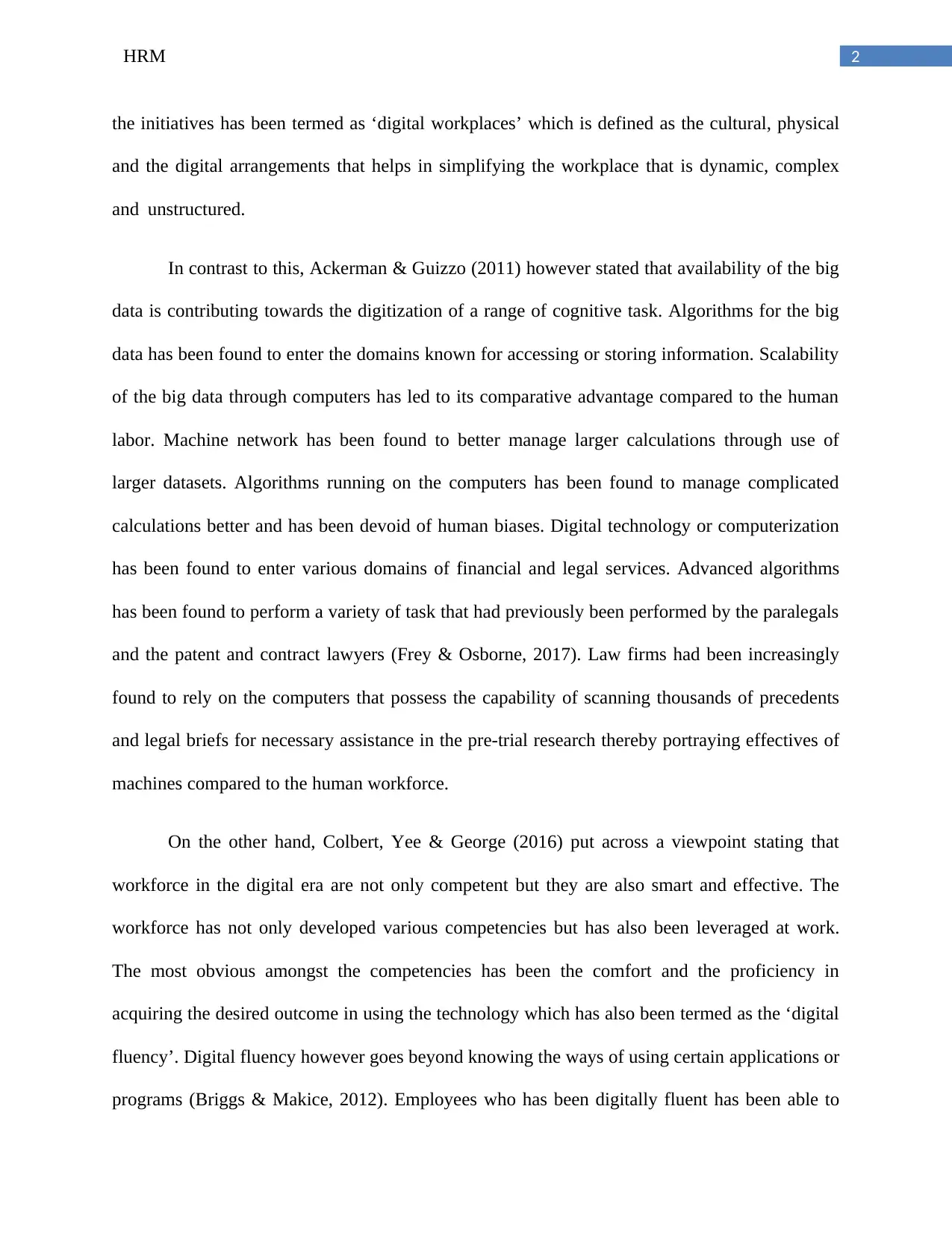
2HRM
the initiatives has been termed as ‘digital workplaces’ which is defined as the cultural, physical
and the digital arrangements that helps in simplifying the workplace that is dynamic, complex
and unstructured.
In contrast to this, Ackerman & Guizzo (2011) however stated that availability of the big
data is contributing towards the digitization of a range of cognitive task. Algorithms for the big
data has been found to enter the domains known for accessing or storing information. Scalability
of the big data through computers has led to its comparative advantage compared to the human
labor. Machine network has been found to better manage larger calculations through use of
larger datasets. Algorithms running on the computers has been found to manage complicated
calculations better and has been devoid of human biases. Digital technology or computerization
has been found to enter various domains of financial and legal services. Advanced algorithms
has been found to perform a variety of task that had previously been performed by the paralegals
and the patent and contract lawyers (Frey & Osborne, 2017). Law firms had been increasingly
found to rely on the computers that possess the capability of scanning thousands of precedents
and legal briefs for necessary assistance in the pre-trial research thereby portraying effectives of
machines compared to the human workforce.
On the other hand, Colbert, Yee & George (2016) put across a viewpoint stating that
workforce in the digital era are not only competent but they are also smart and effective. The
workforce has not only developed various competencies but has also been leveraged at work.
The most obvious amongst the competencies has been the comfort and the proficiency in
acquiring the desired outcome in using the technology which has also been termed as the ‘digital
fluency’. Digital fluency however goes beyond knowing the ways of using certain applications or
programs (Briggs & Makice, 2012). Employees who has been digitally fluent has been able to
the initiatives has been termed as ‘digital workplaces’ which is defined as the cultural, physical
and the digital arrangements that helps in simplifying the workplace that is dynamic, complex
and unstructured.
In contrast to this, Ackerman & Guizzo (2011) however stated that availability of the big
data is contributing towards the digitization of a range of cognitive task. Algorithms for the big
data has been found to enter the domains known for accessing or storing information. Scalability
of the big data through computers has led to its comparative advantage compared to the human
labor. Machine network has been found to better manage larger calculations through use of
larger datasets. Algorithms running on the computers has been found to manage complicated
calculations better and has been devoid of human biases. Digital technology or computerization
has been found to enter various domains of financial and legal services. Advanced algorithms
has been found to perform a variety of task that had previously been performed by the paralegals
and the patent and contract lawyers (Frey & Osborne, 2017). Law firms had been increasingly
found to rely on the computers that possess the capability of scanning thousands of precedents
and legal briefs for necessary assistance in the pre-trial research thereby portraying effectives of
machines compared to the human workforce.
On the other hand, Colbert, Yee & George (2016) put across a viewpoint stating that
workforce in the digital era are not only competent but they are also smart and effective. The
workforce has not only developed various competencies but has also been leveraged at work.
The most obvious amongst the competencies has been the comfort and the proficiency in
acquiring the desired outcome in using the technology which has also been termed as the ‘digital
fluency’. Digital fluency however goes beyond knowing the ways of using certain applications or
programs (Briggs & Makice, 2012). Employees who has been digitally fluent has been able to
⊘ This is a preview!⊘
Do you want full access?
Subscribe today to unlock all pages.

Trusted by 1+ million students worldwide
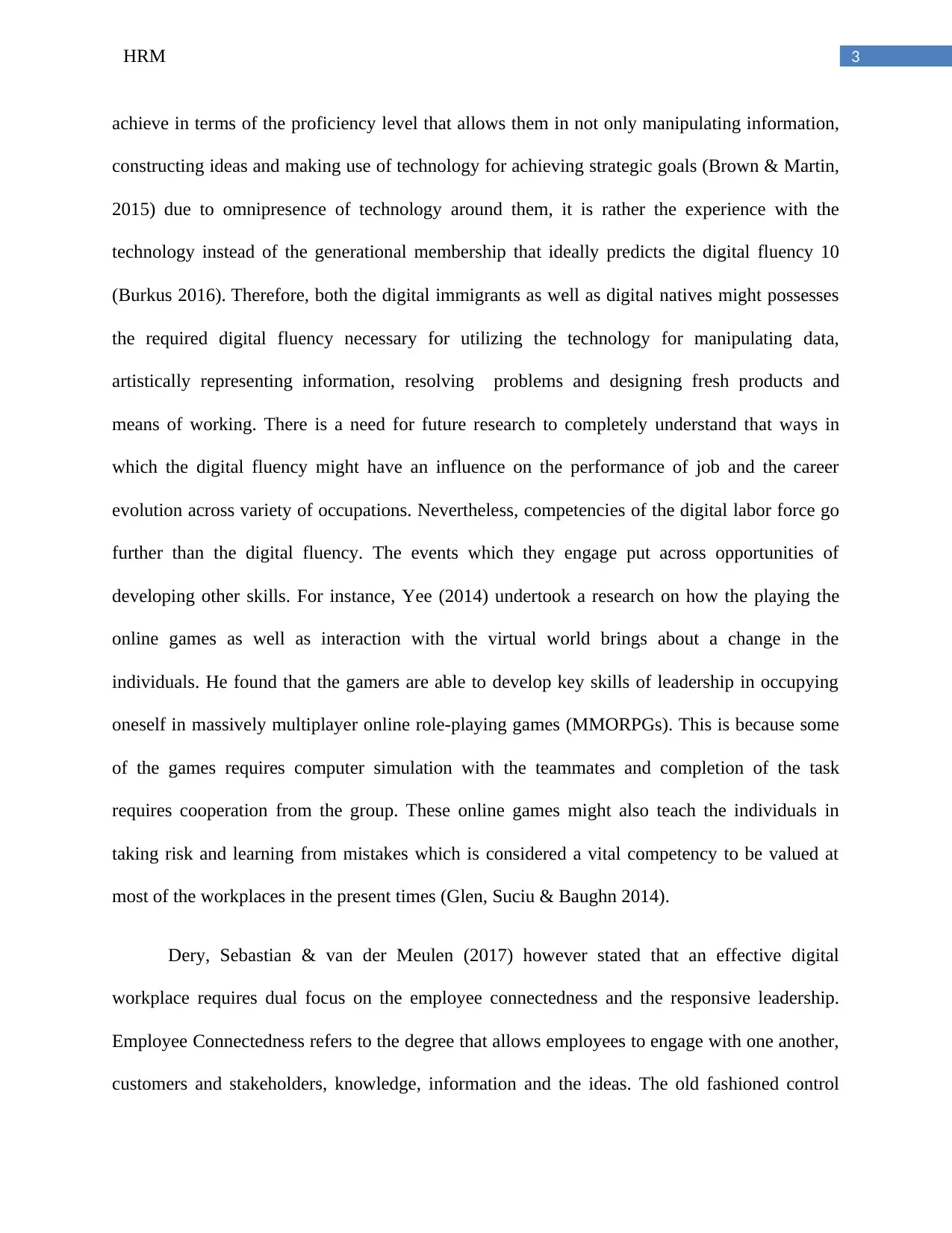
3HRM
achieve in terms of the proficiency level that allows them in not only manipulating information,
constructing ideas and making use of technology for achieving strategic goals (Brown & Martin,
2015) due to omnipresence of technology around them, it is rather the experience with the
technology instead of the generational membership that ideally predicts the digital fluency 10
(Burkus 2016). Therefore, both the digital immigrants as well as digital natives might possesses
the required digital fluency necessary for utilizing the technology for manipulating data,
artistically representing information, resolving problems and designing fresh products and
means of working. There is a need for future research to completely understand that ways in
which the digital fluency might have an influence on the performance of job and the career
evolution across variety of occupations. Nevertheless, competencies of the digital labor force go
further than the digital fluency. The events which they engage put across opportunities of
developing other skills. For instance, Yee (2014) undertook a research on how the playing the
online games as well as interaction with the virtual world brings about a change in the
individuals. He found that the gamers are able to develop key skills of leadership in occupying
oneself in massively multiplayer online role-playing games (MMORPGs). This is because some
of the games requires computer simulation with the teammates and completion of the task
requires cooperation from the group. These online games might also teach the individuals in
taking risk and learning from mistakes which is considered a vital competency to be valued at
most of the workplaces in the present times (Glen, Suciu & Baughn 2014).
Dery, Sebastian & van der Meulen (2017) however stated that an effective digital
workplace requires dual focus on the employee connectedness and the responsive leadership.
Employee Connectedness refers to the degree that allows employees to engage with one another,
customers and stakeholders, knowledge, information and the ideas. The old fashioned control
achieve in terms of the proficiency level that allows them in not only manipulating information,
constructing ideas and making use of technology for achieving strategic goals (Brown & Martin,
2015) due to omnipresence of technology around them, it is rather the experience with the
technology instead of the generational membership that ideally predicts the digital fluency 10
(Burkus 2016). Therefore, both the digital immigrants as well as digital natives might possesses
the required digital fluency necessary for utilizing the technology for manipulating data,
artistically representing information, resolving problems and designing fresh products and
means of working. There is a need for future research to completely understand that ways in
which the digital fluency might have an influence on the performance of job and the career
evolution across variety of occupations. Nevertheless, competencies of the digital labor force go
further than the digital fluency. The events which they engage put across opportunities of
developing other skills. For instance, Yee (2014) undertook a research on how the playing the
online games as well as interaction with the virtual world brings about a change in the
individuals. He found that the gamers are able to develop key skills of leadership in occupying
oneself in massively multiplayer online role-playing games (MMORPGs). This is because some
of the games requires computer simulation with the teammates and completion of the task
requires cooperation from the group. These online games might also teach the individuals in
taking risk and learning from mistakes which is considered a vital competency to be valued at
most of the workplaces in the present times (Glen, Suciu & Baughn 2014).
Dery, Sebastian & van der Meulen (2017) however stated that an effective digital
workplace requires dual focus on the employee connectedness and the responsive leadership.
Employee Connectedness refers to the degree that allows employees to engage with one another,
customers and stakeholders, knowledge, information and the ideas. The old fashioned control
Paraphrase This Document
Need a fresh take? Get an instant paraphrase of this document with our AI Paraphraser

4HRM
and command work ambience inhibited the connectedness across the product or functional silos,
company boundaries and geographies. It was discovered that the higher performing companies
worked towards improving the employee connectedness with the different integrated approaches
through using the three levers of design that helped in enhancing the physical and the digital
communication. Responsive leadership on the other hand referred hand referred to the degree to
which the management is able to prioritize activities which focuses on the constant improvement
and development of employee experience within the organization (Bowles 2016). High
performing firms worked towards building responsive leadership through using the three levers
of design which focused on driving the newer norms of behavior across organization, sustained
focus of leadership on the employee experience, systemic mechanisms of learning along with the
symbols which calls for an explicit workplace strategy. It also included communication of a clear
and articulated vision which linked the new design of the workplace to strategic organizational
objectives thereby driving newer behavioral norms. Responsive leaders seems to create brands
and symbols for highlighting importance of workplace strategy for the digital innovation
(Harper, 2017). Information Technology (IT) leaders in various e high performing firms had the
key role in the development of employee connectedness and responsive leadership. To fulfill the
role they seem to form the cross-functional leadership teams within the digital workplace along
with representatives from facilities, HR, internal and legal communications departments.
According to Katyayani & Rani (2017), digital world that has led to the radical changes
in the workforce as well as the future work further accentuated the HRM function. Human
resource management (HRM) as the function should deploy and embrace technology so that it is
able to support the changes. The conventional practices of HR required reengineering for
completely embracing and incorporating digitization. There is a need for designing the flatter
and command work ambience inhibited the connectedness across the product or functional silos,
company boundaries and geographies. It was discovered that the higher performing companies
worked towards improving the employee connectedness with the different integrated approaches
through using the three levers of design that helped in enhancing the physical and the digital
communication. Responsive leadership on the other hand referred hand referred to the degree to
which the management is able to prioritize activities which focuses on the constant improvement
and development of employee experience within the organization (Bowles 2016). High
performing firms worked towards building responsive leadership through using the three levers
of design which focused on driving the newer norms of behavior across organization, sustained
focus of leadership on the employee experience, systemic mechanisms of learning along with the
symbols which calls for an explicit workplace strategy. It also included communication of a clear
and articulated vision which linked the new design of the workplace to strategic organizational
objectives thereby driving newer behavioral norms. Responsive leaders seems to create brands
and symbols for highlighting importance of workplace strategy for the digital innovation
(Harper, 2017). Information Technology (IT) leaders in various e high performing firms had the
key role in the development of employee connectedness and responsive leadership. To fulfill the
role they seem to form the cross-functional leadership teams within the digital workplace along
with representatives from facilities, HR, internal and legal communications departments.
According to Katyayani & Rani (2017), digital world that has led to the radical changes
in the workforce as well as the future work further accentuated the HRM function. Human
resource management (HRM) as the function should deploy and embrace technology so that it is
able to support the changes. The conventional practices of HR required reengineering for
completely embracing and incorporating digitization. There is a need for designing the flatter
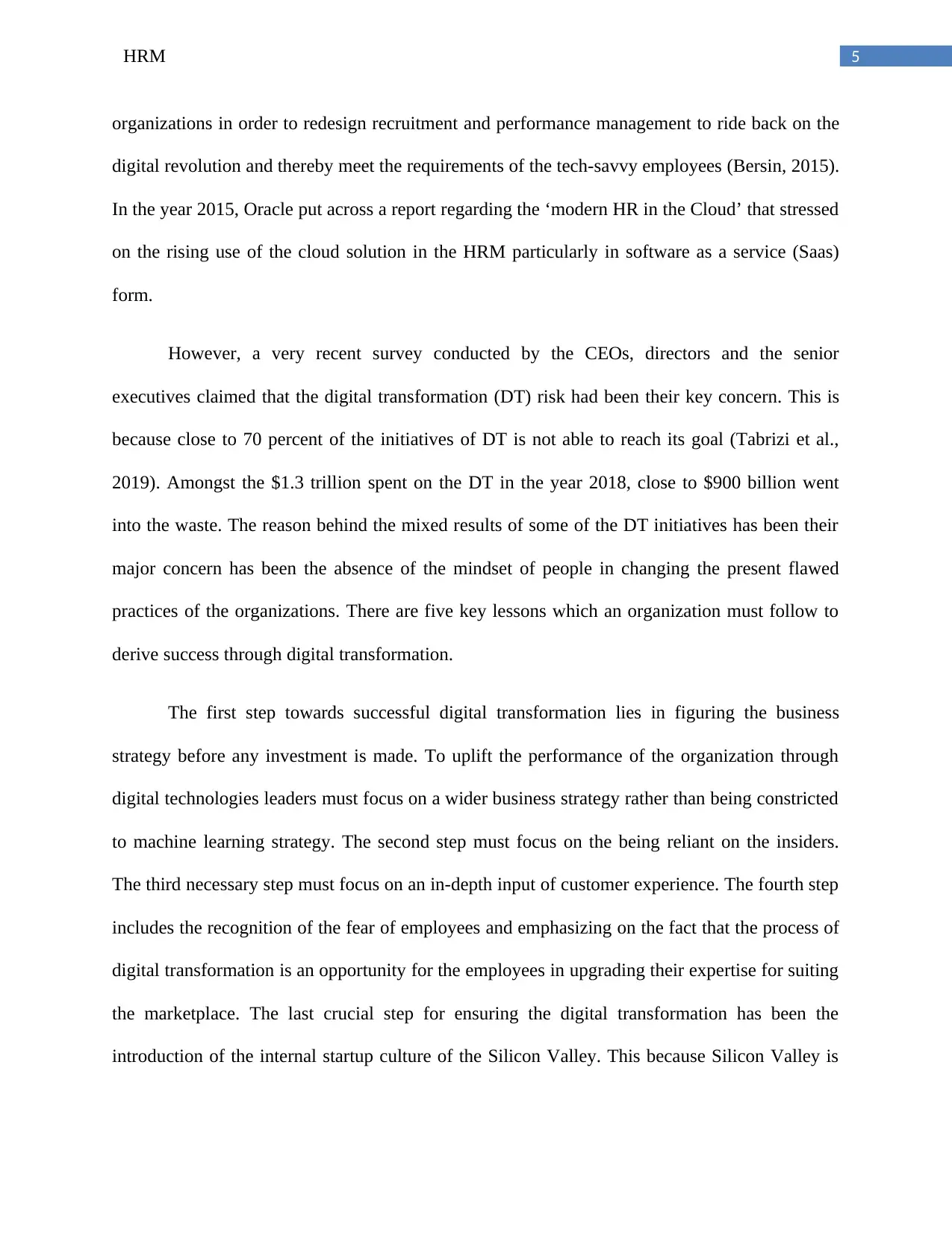
5HRM
organizations in order to redesign recruitment and performance management to ride back on the
digital revolution and thereby meet the requirements of the tech-savvy employees (Bersin, 2015).
In the year 2015, Oracle put across a report regarding the ‘modern HR in the Cloud’ that stressed
on the rising use of the cloud solution in the HRM particularly in software as a service (Saas)
form.
However, a very recent survey conducted by the CEOs, directors and the senior
executives claimed that the digital transformation (DT) risk had been their key concern. This is
because close to 70 percent of the initiatives of DT is not able to reach its goal (Tabrizi et al.,
2019). Amongst the $1.3 trillion spent on the DT in the year 2018, close to $900 billion went
into the waste. The reason behind the mixed results of some of the DT initiatives has been their
major concern has been the absence of the mindset of people in changing the present flawed
practices of the organizations. There are five key lessons which an organization must follow to
derive success through digital transformation.
The first step towards successful digital transformation lies in figuring the business
strategy before any investment is made. To uplift the performance of the organization through
digital technologies leaders must focus on a wider business strategy rather than being constricted
to machine learning strategy. The second step must focus on the being reliant on the insiders.
The third necessary step must focus on an in-depth input of customer experience. The fourth step
includes the recognition of the fear of employees and emphasizing on the fact that the process of
digital transformation is an opportunity for the employees in upgrading their expertise for suiting
the marketplace. The last crucial step for ensuring the digital transformation has been the
introduction of the internal startup culture of the Silicon Valley. This because Silicon Valley is
organizations in order to redesign recruitment and performance management to ride back on the
digital revolution and thereby meet the requirements of the tech-savvy employees (Bersin, 2015).
In the year 2015, Oracle put across a report regarding the ‘modern HR in the Cloud’ that stressed
on the rising use of the cloud solution in the HRM particularly in software as a service (Saas)
form.
However, a very recent survey conducted by the CEOs, directors and the senior
executives claimed that the digital transformation (DT) risk had been their key concern. This is
because close to 70 percent of the initiatives of DT is not able to reach its goal (Tabrizi et al.,
2019). Amongst the $1.3 trillion spent on the DT in the year 2018, close to $900 billion went
into the waste. The reason behind the mixed results of some of the DT initiatives has been their
major concern has been the absence of the mindset of people in changing the present flawed
practices of the organizations. There are five key lessons which an organization must follow to
derive success through digital transformation.
The first step towards successful digital transformation lies in figuring the business
strategy before any investment is made. To uplift the performance of the organization through
digital technologies leaders must focus on a wider business strategy rather than being constricted
to machine learning strategy. The second step must focus on the being reliant on the insiders.
The third necessary step must focus on an in-depth input of customer experience. The fourth step
includes the recognition of the fear of employees and emphasizing on the fact that the process of
digital transformation is an opportunity for the employees in upgrading their expertise for suiting
the marketplace. The last crucial step for ensuring the digital transformation has been the
introduction of the internal startup culture of the Silicon Valley. This because Silicon Valley is
⊘ This is a preview!⊘
Do you want full access?
Subscribe today to unlock all pages.

Trusted by 1+ million students worldwide

6HRM
known for rapid prototyping, decision making and the flat structures which will open up
provision for dealing with the inherent uncertain digital transformation.
Conclusion:
On a concluding note, 42 percent of the employees have been using computers and they
thrive from a population that happens to be a digital workplace. The digital workplace has been
the result of the emergence of a digital world that seems to allow businesses in rethinking the
traditional processes thereby enhancing productivity. The essay discusses that although, big data
has portrayed increased reliance on machines but digital workforce seemed to be smarter enough
in adopting digital fluency. The essay portrayed how technology has also empowered HR. The
essay also portrayed that organizations in order to successfully achieve digital transformation
required to follow certain steps.
known for rapid prototyping, decision making and the flat structures which will open up
provision for dealing with the inherent uncertain digital transformation.
Conclusion:
On a concluding note, 42 percent of the employees have been using computers and they
thrive from a population that happens to be a digital workplace. The digital workplace has been
the result of the emergence of a digital world that seems to allow businesses in rethinking the
traditional processes thereby enhancing productivity. The essay discusses that although, big data
has portrayed increased reliance on machines but digital workforce seemed to be smarter enough
in adopting digital fluency. The essay portrayed how technology has also empowered HR. The
essay also portrayed that organizations in order to successfully achieve digital transformation
required to follow certain steps.
Paraphrase This Document
Need a fresh take? Get an instant paraphrase of this document with our AI Paraphraser
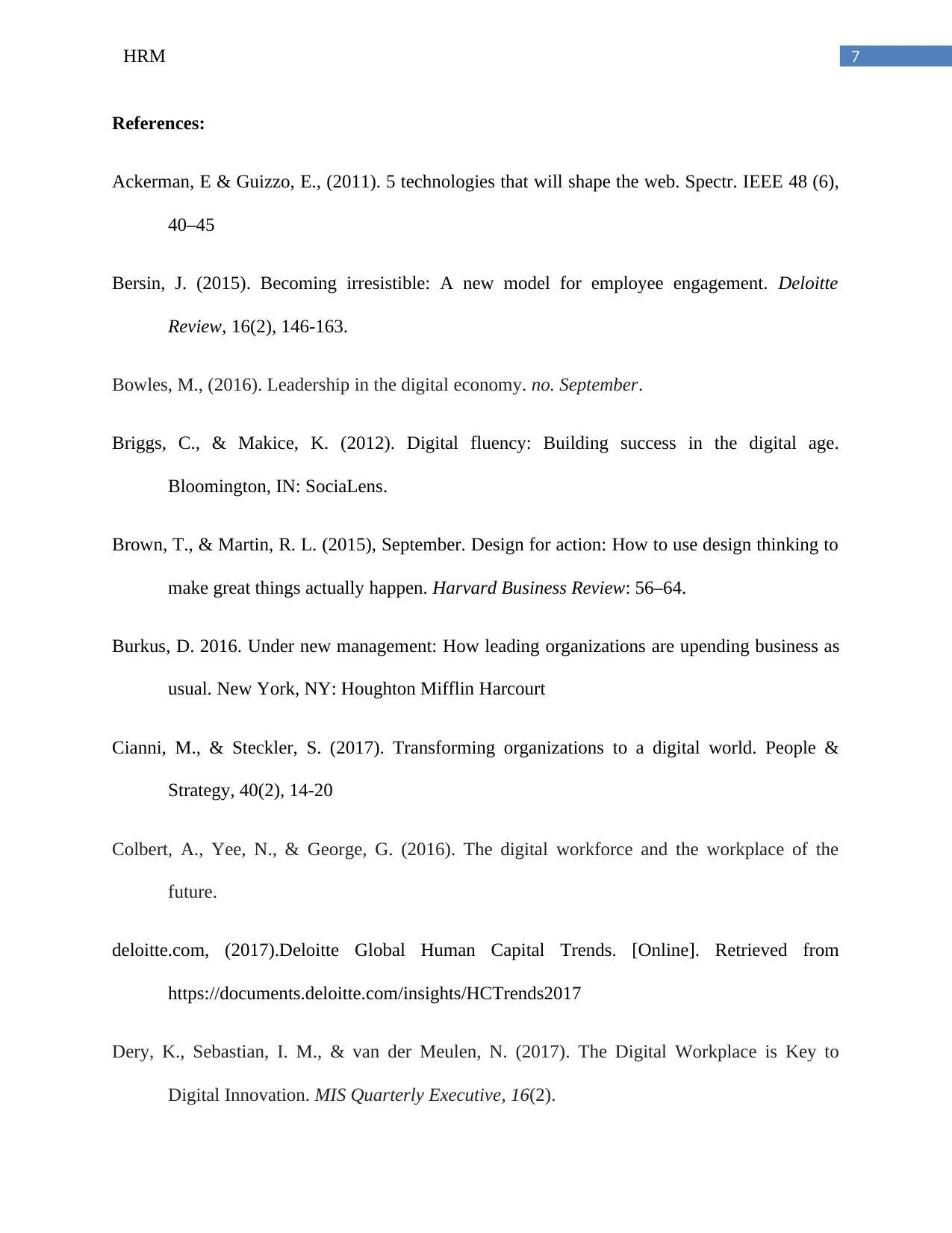
7HRM
References:
Ackerman, E & Guizzo, E., (2011). 5 technologies that will shape the web. Spectr. IEEE 48 (6),
40–45
Bersin, J. (2015). Becoming irresistible: A new model for employee engagement. Deloitte
Review, 16(2), 146-163.
Bowles, M., (2016). Leadership in the digital economy. no. September.
Briggs, C., & Makice, K. (2012). Digital fluency: Building success in the digital age.
Bloomington, IN: SociaLens.
Brown, T., & Martin, R. L. (2015), September. Design for action: How to use design thinking to
make great things actually happen. Harvard Business Review: 56–64.
Burkus, D. 2016. Under new management: How leading organizations are upending business as
usual. New York, NY: Houghton Mifflin Harcourt
Cianni, M., & Steckler, S. (2017). Transforming organizations to a digital world. People &
Strategy, 40(2), 14-20
Colbert, A., Yee, N., & George, G. (2016). The digital workforce and the workplace of the
future.
deloitte.com, (2017).Deloitte Global Human Capital Trends. [Online]. Retrieved from
https://documents.deloitte.com/insights/HCTrends2017
Dery, K., Sebastian, I. M., & van der Meulen, N. (2017). The Digital Workplace is Key to
Digital Innovation. MIS Quarterly Executive, 16(2).
References:
Ackerman, E & Guizzo, E., (2011). 5 technologies that will shape the web. Spectr. IEEE 48 (6),
40–45
Bersin, J. (2015). Becoming irresistible: A new model for employee engagement. Deloitte
Review, 16(2), 146-163.
Bowles, M., (2016). Leadership in the digital economy. no. September.
Briggs, C., & Makice, K. (2012). Digital fluency: Building success in the digital age.
Bloomington, IN: SociaLens.
Brown, T., & Martin, R. L. (2015), September. Design for action: How to use design thinking to
make great things actually happen. Harvard Business Review: 56–64.
Burkus, D. 2016. Under new management: How leading organizations are upending business as
usual. New York, NY: Houghton Mifflin Harcourt
Cianni, M., & Steckler, S. (2017). Transforming organizations to a digital world. People &
Strategy, 40(2), 14-20
Colbert, A., Yee, N., & George, G. (2016). The digital workforce and the workplace of the
future.
deloitte.com, (2017).Deloitte Global Human Capital Trends. [Online]. Retrieved from
https://documents.deloitte.com/insights/HCTrends2017
Dery, K., Sebastian, I. M., & van der Meulen, N. (2017). The Digital Workplace is Key to
Digital Innovation. MIS Quarterly Executive, 16(2).
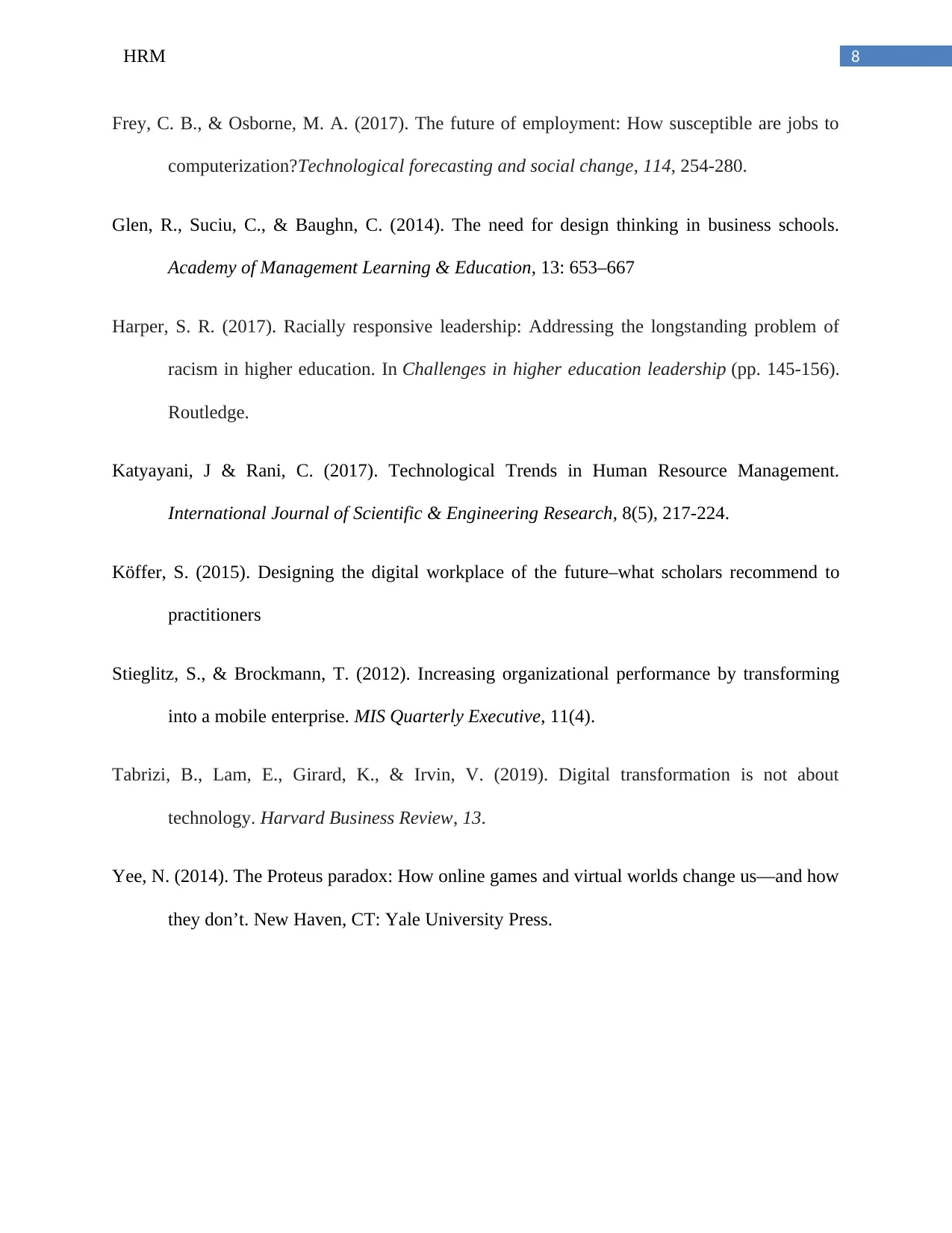
8HRM
Frey, C. B., & Osborne, M. A. (2017). The future of employment: How susceptible are jobs to
computerization?Technological forecasting and social change, 114, 254-280.
Glen, R., Suciu, C., & Baughn, C. (2014). The need for design thinking in business schools.
Academy of Management Learning & Education, 13: 653–667
Harper, S. R. (2017). Racially responsive leadership: Addressing the longstanding problem of
racism in higher education. In Challenges in higher education leadership (pp. 145-156).
Routledge.
Katyayani, J & Rani, C. (2017). Technological Trends in Human Resource Management.
International Journal of Scientific & Engineering Research, 8(5), 217-224.
Köffer, S. (2015). Designing the digital workplace of the future–what scholars recommend to
practitioners
Stieglitz, S., & Brockmann, T. (2012). Increasing organizational performance by transforming
into a mobile enterprise. MIS Quarterly Executive, 11(4).
Tabrizi, B., Lam, E., Girard, K., & Irvin, V. (2019). Digital transformation is not about
technology. Harvard Business Review, 13.
Yee, N. (2014). The Proteus paradox: How online games and virtual worlds change us—and how
they don’t. New Haven, CT: Yale University Press.
Frey, C. B., & Osborne, M. A. (2017). The future of employment: How susceptible are jobs to
computerization?Technological forecasting and social change, 114, 254-280.
Glen, R., Suciu, C., & Baughn, C. (2014). The need for design thinking in business schools.
Academy of Management Learning & Education, 13: 653–667
Harper, S. R. (2017). Racially responsive leadership: Addressing the longstanding problem of
racism in higher education. In Challenges in higher education leadership (pp. 145-156).
Routledge.
Katyayani, J & Rani, C. (2017). Technological Trends in Human Resource Management.
International Journal of Scientific & Engineering Research, 8(5), 217-224.
Köffer, S. (2015). Designing the digital workplace of the future–what scholars recommend to
practitioners
Stieglitz, S., & Brockmann, T. (2012). Increasing organizational performance by transforming
into a mobile enterprise. MIS Quarterly Executive, 11(4).
Tabrizi, B., Lam, E., Girard, K., & Irvin, V. (2019). Digital transformation is not about
technology. Harvard Business Review, 13.
Yee, N. (2014). The Proteus paradox: How online games and virtual worlds change us—and how
they don’t. New Haven, CT: Yale University Press.
⊘ This is a preview!⊘
Do you want full access?
Subscribe today to unlock all pages.

Trusted by 1+ million students worldwide
1 out of 9
Related Documents
Your All-in-One AI-Powered Toolkit for Academic Success.
+13062052269
info@desklib.com
Available 24*7 on WhatsApp / Email
![[object Object]](/_next/static/media/star-bottom.7253800d.svg)
Unlock your academic potential
Copyright © 2020–2025 A2Z Services. All Rights Reserved. Developed and managed by ZUCOL.




